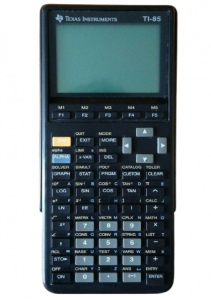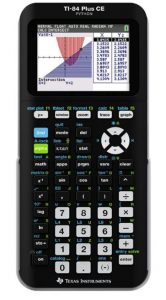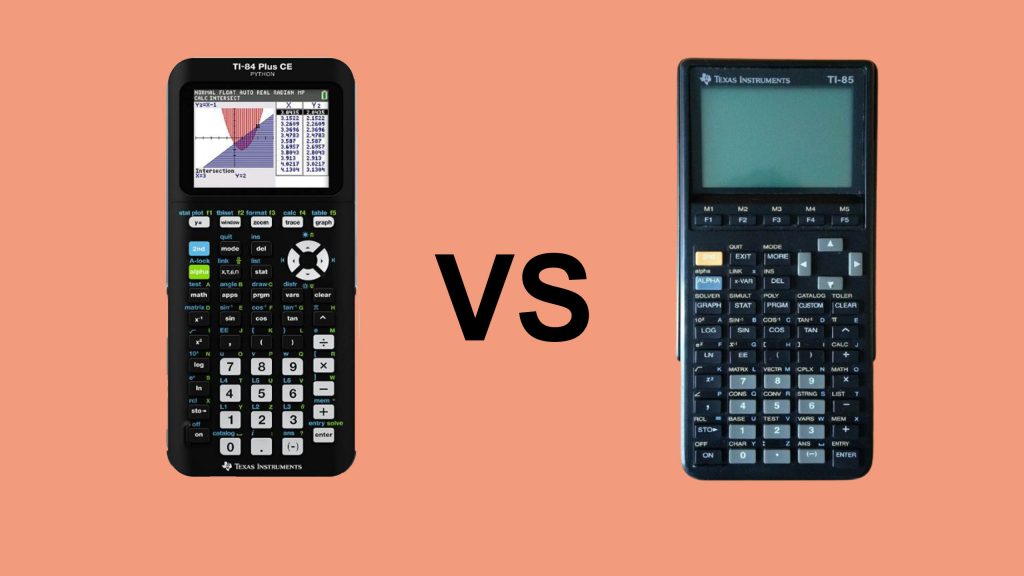When deciding between the TI-85 and TI-84 calculators, it’s crucial to understand their differences in features, performance, and usability. Both calculators are popular for math and engineering, but they cater to different needs. The TI-85 is often favored by professionals and engineers for its advanced math functions, while the TI-84 is more suitable for high school and college students, excelling in graphing and standardized test use. This guide compares the two models in terms of processing power, memory, and overall functionality to help you make the best choice.
Specs Differences Between Ti-85 & Ti-84 Calculator
So here are the main differences between both of these calculators:
| Ti-85 | Ti-84 | |
| Processor | Zilog Z80 6 MHZ | Zilog Z80 15 MHZ |
| RAM | 28K | 128KB |
| Screen Resolution | 128×64 pixels | 320×240 pixels |
| Display | 21 characters per eight lines | 16 characters per 8 lines |
| Graphing Technology | OBSOLETE | ADVANCED |
| Major Functions | Engineering & Calculus | Maths, Interactive Geometry, Algebra, Calculus, Statistics, Graphing |
| Ratings | 4.3 | 4.7 |
TI-85 vs TI-84 Calculator: Which One Should You Choose?
When comparing the TI-85 and TI-84 calculators, focusing on the features that matter most for your needs is essential. Both calculators are well-regarded but serve different purposes for students, engineers, and professionals.
Key Differences at a Glance
| Feature | TI-85 | TI-84 |
|---|---|---|
| Processing Power | Adequate for engineering tasks | Faster, more responsive for graphing |
| Graphing Capabilities | Basic graphing functions | Advanced graphing, better resolution |
| Memory | Less memory for storing programs | Larger memory for complex functions |
| Display | Lower resolution | Higher resolution and clarity |
| Best For | Engineering students | High school and college students |
| User-Friendliness | More technical, harder to learn | User-friendly interface |
Processing Power: Why It Matters
The TI-84 is equipped with a faster processor, making it ideal for handling large graphs and calculations quickly. This can be crucial for high school and college students working on calculus, statistics, and algebra problems. The TI-85 is slightly older, with adequate processing for most tasks but slower when graphing complex functions.
Graphing Capabilities: Which One Excels?
The TI-84 has superior graphing capabilities with a higher-resolution display. It’s more efficient at plotting graphs, especially for students working with more advanced mathematical concepts. The TI-85 offers basic graphing but struggles with more complex plotting tasks.
Memory and Storage: Managing Complex Programs
The TI-84 comes with significantly more memory, allowing users to store multiple programs, apps, and functions. This makes it a better choice for students who need to store formulas and use applications like those for the SAT or ACT. In contrast, the TI-85 has limited memory, which might be a limitation for users who need more storage space for complex calculations or programs.
Display and User Interface: Usability Matters
The TI-84 has a clearer, higher-resolution screen, making it easier to read graphs and numbers. Its interface is designed for ease of use, with more intuitive buttons and a layout familiar to many students. The TI-85 can be harder to navigate, making it less ideal for users who need quick access to functions.
Who Should Use the TI-85?
The TI-85 is best suited for engineering students or professionals needing advanced calculus and matrix functions. However, it’s less user-friendly than the TI-84, making it more appropriate for those with technical experience.
Who Should Use the TI-84?
The TI-84 is ideal for high school and college students. It’s often approved for use in standardized tests like the SAT and ACT, making it a versatile option for a wide range of academic subjects, from algebra to calculus.
Ti-85 Calculator
The Ti-85 was launched in the ’90s as Ti’s second graphing calculator. Not only can it cater to the needs of the students majoring in engineering and calculus. However, this calculator works in solving math, statistics, and science equations.

Equipped with graphing capabilities, the unit is loaded with up to 99 defined graphing functions. It helps you to plot and analyze parametric equations and polar equations simultaneously. It can also compute differential equations.
Ti-85 is ideal for solving pre-algebra and basic statistical functions. It can compute mean, median and mod can solve powers to logarithm, exponents, quadratic polynomial, cubic polynomial, matrix, and regression analysis.
The unit can solve trigonometric functions like cos, sin, tan, and cotan.
This Ti-85 calculator comes with the Zilog Z80 6 MHz processor for faster calculations.
This calculator has a wide display of 8 lines long and 21 characters wide. Such a huge display omits the need to scroll the screen while entering and analyzing data.
This calculator has 28KB RAM to perform multiple mathematical operations without slowing down.
The I/O port design helps to create a connection with other compatible devices such as Ti-86.
The Ti-85 calculator is powered by x4 AAA lithium batteries. Lastly, there’s a year of warranty from Texas Instruments for the Ti-85 calculator.
Pros
- It has a user-friendly interface.
- It is designed for basic engineering and calculus.
- It is programmable.
- It comes with a comprehensive how-to-use guide.
Cons
- It has meagre storage memory.
- The device is not rechargeable.
- A limited range of other functions.
- The device does not support the latest updates and has obsolete features.
Ti-84 Calculator
The Ti-84 calculator is among the advanced versions of Ti calculators. This calculator was launched back in the year 2000. Ti-84 Plus is an ample device for those entering high school or college.

Ti 84 plus supports all the apps of Ti models specifically Ti 83. The calculator is good for statistics, science tools, interactive geometry, calculus, probability, and regression analysis. It also has upgraded graphing technology.
Unlike Ti-85 the unit has an upgraded Zi log Z80 15 MHZ processor and 128 KB RAM, providing enough memory to run the programs without glitches.
What makes Ti-84 different from its predecessors is its easy-to-use interface. Its math print technology allows you to insert the equations and their expressions in proper math format.
Its captivating 320×240 pixels high-resolution LCD visualizes results in a readable form.
Among its pre-loaded apps, graphing is one of the vital functions the unit offers. Ti-84 calculator uses an advanced interface to plot iconic graphing and inequality graphing.
This calculator can draw graphs in six patterns namely scatter, box-and-whisker, XY-line, histogram, and normal probability plots.
The split-screen function previews the equation, its graph, and the coordinates. At the same time. Along with that one can navigate to any point on the graph.
Ti-84 Plus can solve the negative of complex numbers, a function that all the previous Ti models lacked.
The Ti-84 calculator, renowned for its advanced features and reliable performance, is powered by four AAA alkaline batteries, ensuring prolonged usage without frequent battery replacements.
One silver oxide battery is also included to back up the data in case of battery failure.
This calculator also has an I/O port with a USB port to transfer data to your computer.
Pros
- The device is three times faster than its predecessors.
- It provides ample functions at such an economical price.
- The backlit screen makes the device easier to work in dim light.
- The unit has a maximum storage of 128kb.
- Its I/O port helps it to communicate with other Ti devices.
- The unit supports almost all the apps of Ti models specifically ti-83.
- It is approved for PSAT, SAT, and ACT.
Cons
- It is a non-rechargeable device.
- Its monochrome screen can be damaged if under pressure.
Verdict, Ti-85 or Ti-84?
If you’re an engineering student or need advanced math functions, the TI-85 could be the right choice. However, for most students—especially those focused on algebra, calculus, and standardized tests—the TI-84 offers better performance, usability, and advanced graphing features, making it the more versatile option.
Also Read About:

Sheema Ahmed is a passionate writer and educator, specializing in crafting content tailored for individuals preparing for challenging exams such as CSS, SAT, and ACT. Born with a fervour for education, Sheema’s journey began at Hazara University, where she graduated with distinction, solidifying her commitment to academic excellence.
